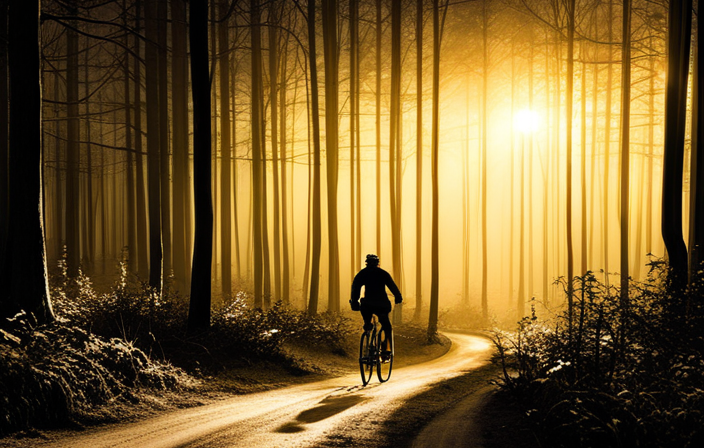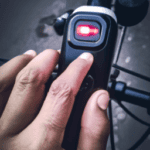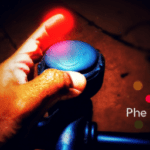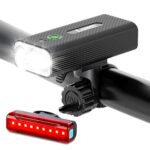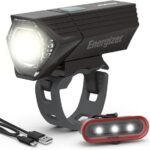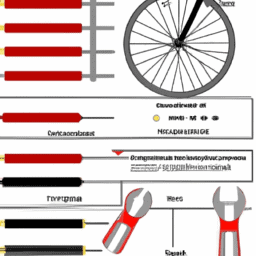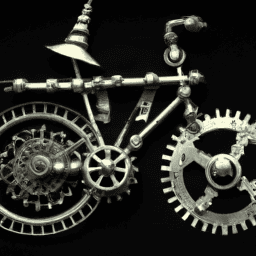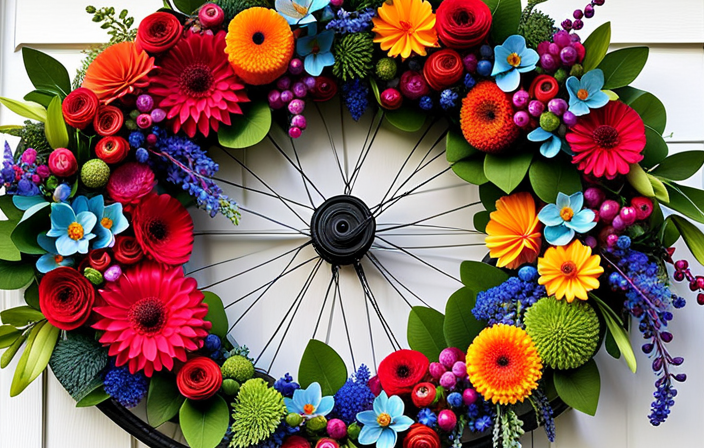Imagine this scenario: you’re riding your bike in the dark, with only a dim light illuminating your path. Out of nowhere, you encounter a pothole and narrowly escape a potential disaster.
It’s clear – having a reliable bicycle light is crucial for your safety on the road. But how do you know how many lumens you need?
In this article, I’ll break down the factors to consider when selecting a bicycle light and help you understand the importance of lumens in different cycling situations.
So, let’s shed some light on this subject and ensure you have the right illumination for your next ride.
Key Takeaways
- Brighter lights increase visibility, reducing the risk of accidents.
- Tailoring brightness to personal preference enhances cycling experience.
- Customizable beam patterns improve nighttime visibility.
- Regularly maintain the battery and adjust the beam angle for optimal visibility and battery conservation.
Importance of a Reliable Bicycle Light
Having a reliable bicycle light is important for ensuring safety while riding at night or in low visibility conditions. The importance of proper maintenance cannot be stressed enough when it comes to bicycle lights. Regularly checking and replacing batteries, cleaning the light lens, and ensuring the light is securely attached to the bike are all crucial steps in maintaining a reliable light source.
Additionally, using a high quality light provides numerous benefits. A high quality light will have a higher lumen output, which means it will emit a brighter and more visible light. This is especially important when riding on roads with heavy traffic or in areas with poor street lighting. A bright light will help alert drivers to your presence and reduce the risk of accidents.
When selecting a bicycle light, there are several factors to consider such as brightness levels, battery life, and mounting options.
Factors to Consider When Selecting a Bicycle Light
When selecting a bicycle light, there are several factors to consider.
First, you need to take into account the riding conditions and environment you will be in. This includes factors such as whether you will be riding in urban areas with streetlights or in rural areas with little to no lighting.
Second, you need to think about your visibility and safety requirements. This includes considering how bright the light needs to be to ensure you are seen by others on the road.
Lastly, you need to consider the battery life and light modes of the bicycle light. This will determine how long the light will last on a single charge and what options you have for different lighting settings.
Riding Conditions and Environment
To determine the appropriate number of lumens for your bicycle light, consider the riding conditions and environment you will be in. Riding comfort and performance can be greatly affected by the lighting conditions, so it is crucial to choose a light that suits your needs.
For example, if you frequently ride on poorly lit roads or off-road trails, a higher lumen output may be necessary to provide enough visibility. On the other hand, if you mainly ride in well-lit urban areas, a lower lumen output might suffice. Additionally, consider factors such as weather conditions and the presence of streetlights.
It’s important to strike a balance between having enough light to see clearly and avoiding blinding other road users. Taking these factors into account will help ensure that you select the right bicycle light for your specific riding conditions and environment.
When it comes to visibility and safety requirements, other important aspects come into play.
Visibility and Safety Requirements
Consider your visibility and safety requirements when choosing a suitable lighting option for your bike. One important factor to consider is the brightness of the bike light, which is measured in lumens. Lumens refer to the amount of light emitted by the bike light.
Choosing the right lumens for your bike light is crucial for ensuring that you are visible to others on the road, especially in low-light conditions or at night. The brightness of the bike light can vary depending on your specific needs and riding conditions. It is recommended to opt for a bike light with at least 200 lumens for urban riding, while off-road or mountain biking may require higher lumens for better visibility.
Understanding the importance of bike light brightness will help you make an informed decision when selecting the appropriate lighting option for your bike.
As we move on to the next section about battery life and light modes, it’s important to consider all aspects of bike light performance.
Battery Life and Light Modes
When choosing the right lighting option for your bike, it’s important to consider how long the battery will last and the different light modes available. Battery capacity is a key factor in determining the runtime of your light before it needs to be recharged. A higher battery capacity means a longer runtime, which is especially important for those who ride their bikes for extended periods.
In addition to battery capacity, it’s also important to consider the light beam intensity and the different light modes available. Some lights offer multiple modes such as steady, flashing, or strobe, allowing you to adjust the brightness and visibility based on the conditions.
Understanding the battery life and light modes will help you choose a bike light that meets your needs and enhances your safety on the road.
Now, let’s dive into understanding lumens and light output.
Understanding Lumens and Light Output
Understanding lumens and light output is crucial when choosing a bicycle light. The brightness of a bike light is measured in lumens, which refers to the total amount of light emitted. Comparing lumens can help determine the brightness of different lights. A higher number of lumens generally means a brighter light. However, it’s important to note that the amount of light actually reaching the road or trail can vary depending on factors such as beam pattern and light distribution. To give you a better idea, here is a table that compares different lumen ranges with their corresponding brightness levels:
| Lumens Range | Brightness Level |
|---|---|
| 100-300 | Low |
| 400-800 | Medium |
| 900-1200 | High |
Understanding lumens and light output can help you choose the right bicycle light for your needs. In the next section, we will explore the recommended lumens for different cycling situations.
Recommended Lumens for Different Cycling Situations
Now that we have a good understanding of lumens and light output, let’s talk about the recommended lumens for different cycling situations.
For urban cycling, it is generally recommended to have a bike light with around 300 to 500 lumens. This will provide enough visibility to navigate through city streets and be seen by other road users.
On the other hand, if you are into off-road biking, you will need a more powerful light. An ideal range for off-road biking is between 1000 and 2000 lumens. This will give you enough light to see the trail ahead and navigate through challenging terrain.
Keep in mind that the ideal lumens may vary depending on personal preference and the specific conditions of your ride.
Speaking of conditions, let’s now discuss considerations for different weather conditions.
Considerations for Different Weather Conditions
When cycling in different weather conditions, it’s important to consider the impact on visibility and adjust your lighting accordingly.
In rainy weather, it’s crucial to have a bicycle light with a higher lumen output to combat the reduced visibility caused by the rain. A light with at least 600 lumens is recommended to cut through the rain and provide a clear beam of light. Additionally, it’s important to choose a light that is waterproof to ensure it doesn’t get damaged in wet conditions.
In foggy weather, a different approach is needed. Using a light with a lower lumen output, around 400 lumens, can help prevent the light from reflecting off the fog and reducing visibility even further.
By considering these weather-specific factors, you can ensure optimal visibility and safety while cycling.
Transitioning into the importance of having a range of lumens, it’s essential to be prepared for different weather conditions and lighting needs.
Importance of Having a Range of Lumens
To ensure optimal visibility and safety while cycling, it’s crucial for you to have a variety of light intensities available for different weather conditions. Having a range of lumens allows you to adjust the brightness levels of your bicycle light to suit the specific conditions you’re riding in.
Here are four reasons why having a range of lumens is important:
-
Versatility: With a variety of brightness levels, you can easily adapt to changing weather conditions, from a bright sunny day to a foggy or rainy evening.
-
Safety: A brighter light can make you more visible to other road users, reducing the risk of accidents, especially in low-light or dark environments.
-
Energy efficiency: Adjusting the lumens to the appropriate level for the conditions can help conserve battery life and ensure you have sufficient light throughout your ride.
-
Personal preference: Having options allows you to tailor the brightness to your own comfort and preference, ensuring an enjoyable cycling experience.
In addition to a range of lumens, there are various additional features to consider in a bicycle light that can further enhance your visibility and safety. [Transition sentence into the next section about additional features to consider in a bicycle light].
Additional Features to Consider in a Bicycle Light
When considering additional features in a bicycle light, there are a few key points to keep in mind.
First, the beam pattern and angle adjustment are important for ensuring optimal visibility on the road.
Mounting options and ease of use are also crucial, as you want a light that can securely attach to your bike and be easily operated while riding.
Lastly, durability and water resistance are essential factors to consider, as these features will ensure that your light can withstand various weather conditions and last for a long time.
Beam Patterns and Angle Adjustment
The beam patterns and angle adjustment of bicycle lights can greatly impact visibility. Having the ability to customize the beam pattern allows cyclists to tailor their light to their specific needs. Whether you prefer a narrow beam for a focused, long-distance illumination or a wider beam for broader coverage, beam pattern customization ensures improved nighttime visibility.
Additionally, angle adjustment is crucial in directing the light exactly where it is needed, preventing blinding oncoming traffic while still illuminating the road ahead. These features work together to enhance safety during nighttime rides.
Moving on to mounting options and ease of use, it is important to consider how the light attaches to the bike and how easy it is to adjust and operate.
Mounting Options and Ease of Use
Consider the different mounting options and how easy the light is to use and adjust. When choosing a bicycle light, it’s important to take into account the mounting options available and the overall user-friendly design. Here are four key factors to consider:
-
Handlebar Mount: Look for a light that offers a secure and adjustable handlebar mount. This ensures that the light stays in place while riding on rough terrains.
-
Helmet Mount: Some lights come with a helmet mount option, allowing you to direct the light wherever you look. This offers added flexibility and visibility.
-
Quick Release System: Opt for a light that features a quick release system for hassle-free installation and removal. This makes it easy to take the light with you when you park your bike.
-
Intuitive Controls: Choose a light with user-friendly controls that are easy to operate, even while riding. Look for large buttons or switches that can be easily accessed and adjusted on the go.
Considering these mounting options and user-friendly design can greatly enhance your cycling experience.
Now, let’s move on to discuss the durability and water resistance of bicycle lights.
Durability and Water Resistance
One important factor to keep in mind is the durability and water resistance of the chosen bike light. When riding in different weather conditions or rough terrains, it is crucial to have a bike light that can withstand the elements and continue to perform at its best. To ensure durability, bike light manufacturers often subject their products to rigorous testing, including impact resistance tests and vibration tests. Additionally, waterproofing techniques, such as the use of rubber seals and specialized coatings, are employed to protect the internal components of the light from water damage. To give you a better understanding, the table below outlines the durability testing and waterproofing techniques used in some popular bike lights:
| Durability Testing | Waterproofing Techniques |
|---|---|
| Impact Resistance Test | Rubber seals |
| Vibration Test | Specialized coatings |
Considering these factors will help you choose a bike light that is built to last and can withstand harsh conditions. Now, let’s move on to the next section where we will discuss reviews and recommendations for bicycle lights.
Reviews and Recommendations for Bicycle Lights
Looking for recommendations on bicycle lights? Need to know how many lumens you should get? Well, you’ve come to the right place.
When it comes to choosing the right bicycle light, it’s important to consider the reviews and recommendations from fellow cyclists. Here are three top-rated brands and best budget options to consider:
-
Cygolite Metro Plus 800: This powerful light offers 800 lumens and has a long battery life, making it perfect for longer rides.
-
NiteRider Lumina 1200 Boost: With 1200 lumens, this light provides excellent visibility and has multiple brightness settings to suit your needs.
-
Blackburn Dayblazer 800 Front Light: Affordable and reliable, this light offers 800 lumens and is water-resistant, ensuring durability.
Now that you have some options, let’s move on to the next section where I’ll give you some tips for properly using and maintaining your bicycle light.
Tips for Properly Using and Maintaining Your Bicycle Light
To ensure optimal performance and longevity of your bike light, it’s crucial to follow these tips for proper usage and maintenance.
First, make sure to regularly maintain the battery of your bicycle light. This includes charging it fully before each ride and avoiding overcharging.
Additionally, it’s important to adjust the beam angle of your light to suit your needs. A higher beam angle is ideal for riding on dark trails, while a lower angle is better for city streets. By adjusting the beam angle accordingly, you can maximize visibility and conserve battery life.
In conclusion, by properly maintaining your bike light’s battery and adjusting the beam angle, you can ensure a safe and enjoyable riding experience.
Conclusion and Final Thoughts
In conclusion, it is important to properly maintain and adjust your bike light for a safe and enjoyable ride. Here are some final thoughts on the pros and cons of different bicycle light mounting options, as well as common mistakes to avoid when choosing a bicycle light.
-
Handlebar Mount:
Pros – easy to install, provides a wide beam of light.
Cons – can obstruct your view if not positioned properly. -
Helmet Mount:
Pros – allows you to direct the light where you need it most, provides better visibility in turns.
Cons – can make your helmet heavier and less comfortable. -
Seatpost Mount:
Pros – keeps the light out of your line of sight, provides good visibility from behind.
Cons – may not provide as much light in front. -
Frame Mount:
Pros – keeps the light secure and stable, doesn’t interfere with your handlebar or helmet.
Cons – may require additional installation steps.
When choosing a bicycle light, avoid these common mistakes: buying a light with insufficient brightness, neglecting to check the battery life, choosing a light that doesn’t have different brightness settings, and overlooking the importance of being visible from all angles.
Remember, a properly chosen and maintained bicycle light is essential for your safety on the road.
Frequently Asked Questions
Can I use a flashlight as a bicycle light?
Yes, you can use a flashlight as a bicycle light, but using a headlamp instead is a better option. Pros of using a flashlight include affordability, but cons include limited visibility and mounting difficulties.
Are there different types of bicycle lights available?
Yes, there are different types of bicycle lights available. They include front lights, rear lights, and combination lights. Each type offers unique benefits such as increased visibility, improved safety, and the ability to see and be seen in various lighting conditions.
How long do bicycle lights typically last before they need to be replaced?
Bicycle light lifespan can vary depending on usage and quality. Generally, they last anywhere from 1,000 to 50,000 hours. It’s important to replace them when they start to dim or flicker, ensuring optimal visibility and safety on the road.
Can I use a bicycle light during the daytime?
Sure, you can use a bicycle light during the daytime for added visibility benefits. It helps motorists see you better and increases your safety on the road. Additionally, bicycle lights have alternative uses like camping or hiking.
Are there any legal regulations regarding the use of bicycle lights?
Yes, there are legal regulations regarding the use of bicycle lights. These regulations ensure safety standards are met, such as having a white light on the front and a red light on the back.
Conclusion
In conclusion, selecting the right bicycle light is crucial for a safe and enjoyable cycling experience. Understanding lumens and light output helps determine the appropriate brightness for different situations.
Just like how a lighthouse guides ships through the night, a reliable bicycle light illuminates the path ahead, ensuring visibility and preventing accidents.
Remember to consider weather conditions and additional features, and read reviews for recommendations. Properly using and maintaining your bicycle light will ensure its effectiveness.
Stay safe and pedal on!
